So you’ve made the decision to take your Corvette touring…now what? With a careful trip preparation checklist, you can avoid the embarrassment of having your car towed to the nearest garage.
If your car is driven regularly, minimal preparation is required. If it’s been in storage long, take short trips first to discover any possible surprises that might occur before embarking on a long journey. Allow plenty of time to prepare your car because rushing repairs last minute adds extra aggravation. Keep in mind, most shops prefer time to evaluate and make necessary repairs. Rushing maintenance can come back to haunt you. If budget is an issue, start with any safety issues.
A year can go by more quickly than we realize. Because of our fast-paced lives, our vehicles suffer from neglect. Annual inspection, however, facilitates a road trip any time by revealing potential problems before they occur. Many Corvette owners ritually change their own oil and filter so they can inspect the underhood and underside areas. Minor problems can be spotted that might otherwise have gone unnoticed at a quick lube facility, which may not be in tune with Corvette inspection requirements.
Now is the time to change all those vital fluids. Most road trips are easier on fluids, as opposed to daily city driving. Mountainous and desert driving causes the most strain. At the very least, the engine oil and coolant should be changed. I prefer to change all fluids—transmission, differential, cooling system, brake fluid, power steering—every two years, during regular use; if it sits, I change fluids every year.
Let’s start with the brake system. If you feel pedal pulsation when applying the brakes, it is a warning. Brake pedal pulsation usually occurs when brakes are overheated, due to multiple applications at high speed. If rotors are at minimum thickness, they will also be susceptible to warping, so the brake system may need costly repairs. Pads and shoes should be checked for minimum thickness. Inspect rotors for minimum thickness and cracking. Cracked or damaged rubber brake hoses are common. Dirty, moisture-laden brake fluid can make mountainous driving dangerous.
If you have not had recent brake service on a Gen 1, 2, or 3 Corvette, check the brake wheel cylinders or calipers for leaks. Even a small leak can be a major problem on disc brake cars. Caliper pistons may start to move around, leading to leaky calipers.
No record of wheel bearing service at 50,000 miles or more means it’s time to pack the bearings and replace the seals. Failed bearings emit a light roaring noise at 50 MPH which increases exponentially, vibrating the floorboards. If you notice a roar from a wheel area beginning at highway speeds most likely you can make it home before any major damage occurs. 1984-2014 Corvettes have sealed wheel bearings that require replacement.
While the wheels are removed for brake inspection, check the tires for incorrect wear or damage. Inflating your tires to maximum pressure will increase fuel mileage and should be checked a few times during the trip. Low tire pressure can cause excessive heat or severe tire damage. Most wheel and tire combinations lose some air. Keep an eye on pressure if you have one that tends to lose a small amount of air over time.
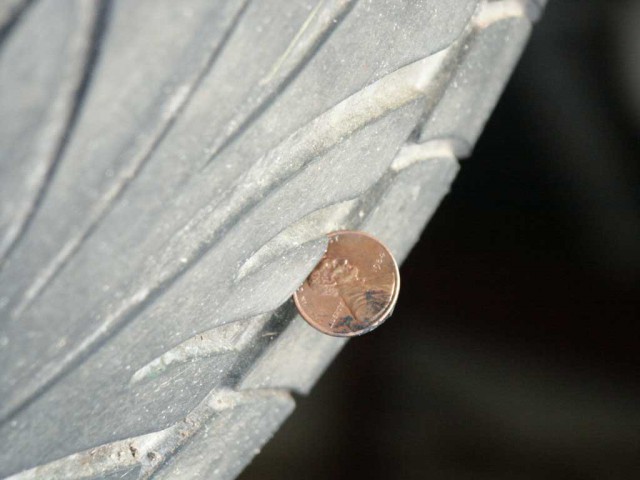
A penny can be used to check tread depth. Place the penny with Lincoln’s head into the tread in several areas. The hair on Lincoln’s head should be at or below the tread.
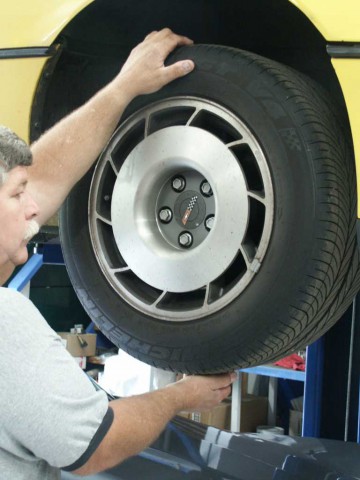
Grab the wheel at the top and bottom and see if it moves more than a quarter inch. Additional movement indicates worn bearings or possible spindle damage.
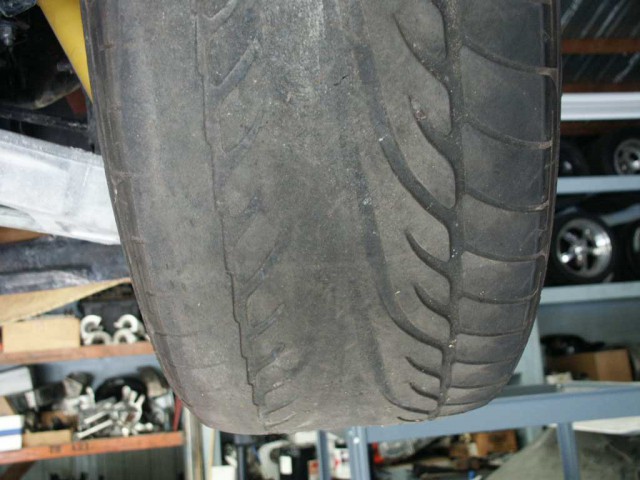
If the outer or inner edges of the tire are worn, have the alignment checked. If the tires are worn on the outer edges or in the center only, check tire pressure. If your tires are wearing evenly across the tread, have them high speed balanced for a more pleasurable ride.
Next, we look under the car. Cracked suspension bushings are expected, not of major concern. Gen 2 and 3 cars are hard on rear strut rod bushings. When a u-joint fails, it is usually due to lack of lubrication. A telltale sign is a rust trail emitting from the u-joint cup. The same rust streaks appear when fasteners are loose.
Gen 2 and 3 cars should have trailing arm bushings checked carefully. Of all bushings in the suspension system, bad trailing arms will make the car scary to drive. Failed bushings cause the car to rear steer one way during acceleration and in the opposite direction during deceleration. Driving around the block can feel like an eternity and long trips can be suicide.
Gen 2 and 3 cars are also known for front upper and lower control arm bushing damage. Upper bushings get beat out from rough roads, while lowers get soft from fuel and oil leaks. C4 and C5 suspension bushings are more durable, but C4s are old enough to see failed bushings. Almost all Gen 2 and 3 cars have weak or torn steering shaft couplers. Although there is a failsafe device to prevent loss of steering completely, excessive steering play can be very annoying on a long trip. Grab the steering linkage idler arm and see if it has any movement up and down, which may increase steering wheel play. Take a close look at the power steering hoses on Gen 2 and 3 cars. Cracked, chafed power steering hoses will most likely blow out 100 miles from nowhere. Running the vehicle low on power steering fluid is an option but pump failure will be imminent.
Under the hood, look at belts for cracking, missing pieces, etc. The C4 and C5 serpentine belt is durable but keep in mind it uses both sides of the belt. C4 and C5 idler and tensioner pulleys are made from plastic and can be damaged from debris. If you see serpentine belt damage, look closely at the pulleys. The 1992 Corvette uses a double ribbed serpentine belt that can be difficult to find in a big city, let alone in remote areas, so it is definitely something to include in your emergency kit. Luckily, I have only dealt with a couple belt failures and drove the rest of the trip watching the temperature gauge. Above two hundred, I shut off the engine and coasted to a stop. After it cooled, I continued until I was able to find a new belt.
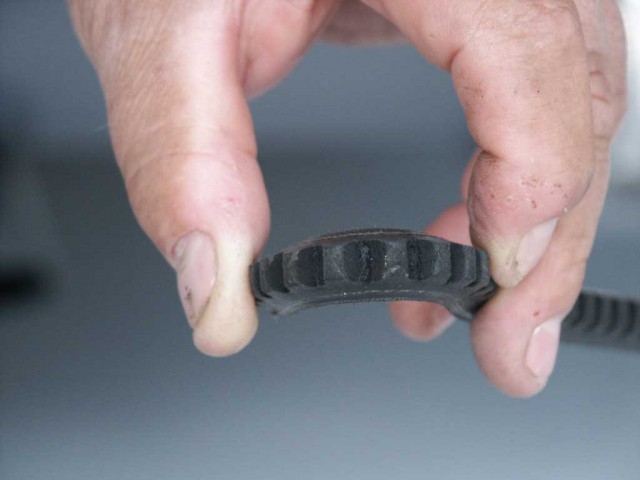
Accessory drive belts start to crack from the underside. A long road trip will strain an already weakened belt. A good quality name brand belt is important for replacement. I see bargain drive belts with lifetime warranties that won’t last 10,000 miles. The warranty maybe good but how many times do you want to replace a belt annually?
A blown cooling system hose can be disastrous. Underhood temperatures are elevated due to space confines and all rubber products take abuse from heat. If you have a C4 with an LT1 engine, there is a good chance you’ll be walking. Unfortunately, there is no quick fix for a wet stock LT1 distributor. The upper radiator hose on 92-94 LT1 engines handles a lot of heat and should be checked periodically. Lower radiator hoses in general last longer than upper because they are returning cooled water to the engine. However, if you have an overheating engine, all hoses are punished. Gen 2 and 3 cars tend to receive lower radiator hose damage when the A/C belt gets loose and slaps the lower radiator hose. Check heater hoses on Gen 2 cars for possible exhaust heat damage.
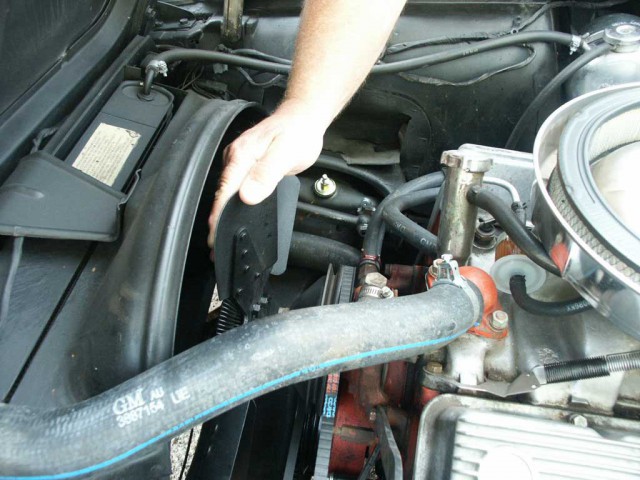
When checking the Gen 1, 2, and 3 cars, grab the cooling fan assembly and see if it has play. It is also typical to find worn water pump bearings when checking for fan clutch wear. If you find a wiggle, look carefully to determine if the fan clutch or water pump (or both!) are loose.
There is nothing quite like the experience of using duct tape to repair a blown hose and then filling the cooling system with water from the nearest ditch. If your hoses have 75,000 miles or overheating has occurred, replacement is a good idea. The hoses may last 100,000 miles, but at that point they should no longer be trusted. If you have increased coolant temperatures on the highway, look for debris that might have been sucked into the radiator area. The air dam is also important on Gen 3, 4, and 5 cars because it forces air into the radiator area. 1963 – 1967 cars exhibit increased coolant temperature with a front license plate installed. Examine Corvettes with modified engines thoroughly for possible chafing or heat damage of all hoses, pulleys, and belts before the trip.
Check fuel lines and hoses for leaks. Look at the fuel pump area on Gen 2 and 3 cars for cracked hoses and leaky fittings. The Gen 3 fuel pump uses a molded rubber fuel supply and return hose for maximum flow. If a straight piece of hose is used, fuel flow can be restricted at highway speed. Many times, a section of rubber hose is used for connection on a replacement carburetor without the same configuration fuel supply line as the original. Another common thing I see is a glass sleeve aftermarket fuel filter that is susceptible to breakage and flammability. Check these hoses and glass filters often for cracking or heat damage. Gen 4 and 5 cars with over 100,000 miles are candidates for electric in-tank fuel pump replacement.
Electrical and ignition systems are not typically troublesome until they have accrued 75,000 miles. 1986-1991 cars being the exception, the CS130 O.E. alternator is on borrowed time, even at low mileage. The upside is a long road trip is better for the CS130 alternator if the bearings don’t fail. Earlier and later alternators are good for a minimum 100,000 miles if the battery has been maintained. As long as the battery is less than four years old and acid is not leaking out of the side post battery cable mounting lugs, it should be good to go.
An ignition system in poor shape can make a trip aggravating, but would hopefully get you home. Catalytic converter-equipped cars with ignition system problems can create excessive exhaust heat and damage. Plug wire damage can occur when plug wires are laid on the exhaust manifolds and I see this all the time. When the plug wires are installed correctly on the Gen 1, 2, and 3 cars they can become oil-soaked due to their positioning, but over the long term they are less susceptible to burning on the exhaust. Shorted spark plug wires can damage the 1975-1991 HEI (High Energy Ignition) systems.
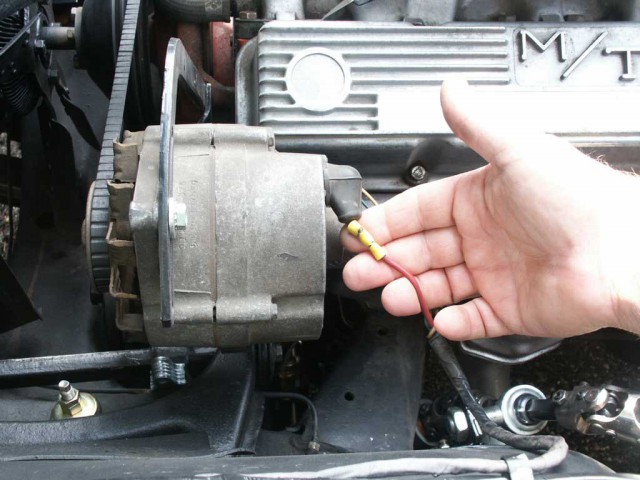
If you find miscellaneous wire connectors applied to your wire harness, check them closely for poor connections which create resistance and additional heat. A butt connector installed so closely to another terminal is hard to crimp properly. It would be better to create and install a one foot repair lead.
Check all exterior lighting. Verify proper rotation of Gen 4 headlamps. When the hood is up, watch the motor manual override knobs for additional movement after the headlights have stopped rotating. If the motor spins longer than it should, you will end up with a headlight flopping in the breeze. Check the wiper blades and washer for proper operation.
Think about how many accessories you may be using and plan for additional wiring. With so many toys available, one cigarette lighter receptacle is not enough for the additional load. If an accessory uses high amperage connect it directly to the battery. Put an assortment of extra fuses in the glove box.
Early cars with points and condenser ignitions should have a spare set available along with a 1/8” Allen wrench for adjustment. Include a set of belts or serpentine belt. I usually give the customer their old belts back for use in an emergency situation. A bag of 8” wire ties and duct tape can do amazing things in a pinch.
A set of lug nuts for one wheel and key for the wheel locks should be placed in a waterproof plastic bag. Make sure you have a working jack, lug wrench, and air in the spare tire if your car is not equipped with run flat technology. If you have custom wheels, make sure you have the necessary tools to remove the wheels. A can of WD-40 or CRC 5-56 can make life easier if the spare tire holder is stiff or the lug nuts are difficult to remove. A small container of kerosene is a handy solvent to take with you. Kerosene removes road tar easily from the rocker areas if it is cleaned quickly.
A small first aid kit and fire extinguisher that is easy to access is important. It is also a good plan to bring a high quality tire pressure gauge and reliable flashlight.
Story and photos courtesy Chris Petris

I bought my 2014 corvette from Alaska Sales and Service in Anchorage, Alaska, they do all my oil changes and maintenance on my corvette. I would recommend anyone to bring your corvette to your Chevy dealership that sells corvette’s I totally trust and like Alaska Sales and Service mechanics. I plan on going on a road trip and I just reviewed a article on maintenance before going on a road trip. I gave many things to watch for and change before going on long trips. What really seems is good is to change all fluids and look at your belts.
I really wish I could find a shop to address the issues that I can’t on my 1981 corvette. We are really tired of getting ripped off. I spent almost $4k year before last and all I got was a broken front windshield and four return trips to the same shop for the same trans leak. Then ended up having to have the trans rebuilt for another $1100 at another shop who stated the other shop didn’t know what they were doing. We want to take the corvette for a road trip in Aug. However, I’m not sure it’s ready. Is there a corvette/repair shop you could recommend in the Novi, Michigan area?
Masterworks in Madison Heights. Owner (Werner Meir) is an NCRS judge. Does mostly Corvettes.
My husband got a Corvette a few years ago, and he wants to take it on a trip. Since it is an older model, I think it would be good for him to do some of these things on this checklist. It might be especially good for him to get the brakes checked, since he said they aren’t working like they used to. I would feel a lot better about him going on a trip if everything was fixed up! Since his is quite old, do you think he will still be able to get parts for it?
Hi Julie! Chances are, you’ll be able to find nearly any part your husband might need to prep, repair or replace at our site. Check out our C1 (1953-1962) store or one of the other generations, if he has a different year.
That is awesome that you have all these parts available on your site! I will be sure to look at that and see if I can find the right year. I’m sure he’ll be really excited to find the right parts for his car, because up to this point he’s been having troubles finding what he needs. Thanks so much!